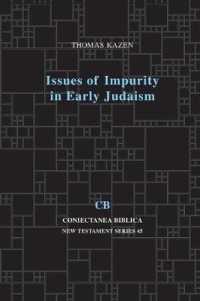- ホーム
- > 洋書
Full Description
What did Jesus think about Jewish practice regarding impurity? How did he relate to the inner-Jewish debates of his day concerning ritual purity and impurity? Did he discard the impurity concept altogether, or was it an obvious and natural part of his Jewish faith and life? Did he advocate another or different type of purity?Ritual or cultic purity was paramount in Jewish society and life during the Second Temple period, and differences in purity halakhah were one of the factors that distinguished various movements. Therefore, considering purity is crucial in any attempt to interpret the historical Jesus within his contemporary context. In the latest or "third" phase of historical Jesus study, researchers have given prominence to Jesus' social and cultural context. In keeping with this goal, Thomas Kazen discusses the historical Jesus alongside what we know of Jewish purity halakhah of his time and explains Jesus' attitude toward impurity. Kazen balances the work of New Testament scholars on Judaism and legal matters by incorporating the historical Jesus studies of Jewish scholars, seeking to engage students of the historical Jesus with the primary materials relating to legal matters.
Contents
PART ONEI. Jesus and purity: an introductionI.1 The idea of impurityThe Jewish impurity systemPurity laws during the Second Temple periodI.2 Jesus' attitudeThe problemSourcesContents and structureII. Jesus and history: problems and possibilitiesII.1 The historical Jesus and purityTrends and tendencies in the "quests"A Jewish JesusJesus and purity issuesII.2 Continuity and authentic traditionsMore than a problem of criteriaWords are not enoughTradition is redaction tooConstraints and plausibilityII.3 The limits of historical reconstructionHistory is more than factsCausation, intention, and "thick description"Getting down to what?-authenticity, reality, and retrodictionSummary: A case for the historical Jesus as conscious reconstructionPART TWO: LAW, PURITY AND BODYIII. Jesus and the law: much debated conflict storiesIII.1 Evaluating legal issuesIdentifying Jesus' adversariesIdentifying points of conflictIdentifying contemporary legal materialThe Sabbath as a test caseIII.2 Mark 7, hand-washing, and the impurity systemStructure and contentTradition, redaction, and authenticityHand-washing and eating at the time of JesusAn expansionist purity practice in Second Temple JudaismDegrees of impurity and contamination chainsLiquids, stone vessels, and the impurity of handsSummary: A case for purity as a wide-spread concern in Second Temple JudaismIV. Jesus and defilement through contact: a neglected issueIV.1 An alternative approachBeginning with non-conflict traditionsDealing with miracle storiesTracing historical reminiscencesIV.2 Skin disease / "leprosy""Lepers" in gospel traditionsThe Markan non-conflict traditionJesus' gesturesBiblical legislation concerning "leprosy"The exclusion of "lepers" in the Second Temple periodThe contamination of "lepers""Leprosy" as punishmentThe Lukan traditionPapyrus Egerton 2Jesus and "leprosy"IV.3 Bodily dischargesThe major dischargersThe bleeding woman and Markan sandwich constructionA purity issue in the Markan traditionDischargers in Lukan traditions?Interpreting the purity issue: biblical legislationExpulsion or isolation of dischargers during the biblical periodEqualization and strictness in the Second Temple periodEqualization and leniency in rabbinic interpretationExclusion and isolation at the time of JesusThe bleeding woman and contamination by touchJesus and dischargesIV.4 The corpseThe nature of corpse-impurityA purity issue in resurrection stories?The Markan tradition about Jairus' daughterThe widow's son in Lukan traditionThe impurity of graves and Jesus' attitudeWas corpse-contamination avoided?Purification and the first-day ablutionThe good Samaritan and a presumptive corpsePriestly purity and priorityJesus and corpse-impuritySummary: A case for Jesus' attitude as seemingly indifferentPART THREE: EXPLANATORY MODELSV. Purity and moralityV.1 Immorality and bodily defilement in ancient JudaismSin and impurityRitual and moral in biblical legislationA moral trajectoryAlternative categories: inner and outerV.2 Jesus: inner and outer impurityTraditions and sourcesInner and outer impurity in Q and the Gospel of ThomasMark 7 revisitedV.3 John and Jesus: inner and outer purificationJohn the BaptizerThe Baptizer and QumranJesus and baptisms in gospel traditionsJesus and purification ritesPapyrus Oxyrhynchus 840 and inner purificationSummary: A case for Jesus as part of a moral trajectory in JudaismVI. Purity and diversityVI.1 Common JudaismsGeneralizing tendencies and the necessity to differentiateJesus and the major partiesThe influence of the major groupsExpansionists and common peopleJesus and the common peopleVI.2 Social and regional differencesGreat and little traditionPopular traditionsNorthern literary traditionsThe Galilean populationWhat type of Judaism?VI.3 Centre and peripheryUrbanization and hellenizationTown and countrySepphoris or Jerusalem? Orthogenetic and heterogenetic citiesBeyond great and little traditionJesus and Pharisees in GalileeSummary: A case for Jesus' attitude as a reaction to a Galilean dilemma onpurityVII. Impurity and demonic threatVII.1 Demonology and impurityDemons in ancient IsraelHealing and exorcismImpurity and exorcism in the Israelite cultImpurity and demons in Second Temple JudaismVII.2 Jesus as exorcistTraditions about Jesus' exorcismsA Jewish Cynic?A Galilean hasid?A Solomonic magician?A messenger of the eschatological kingdomImpurity and power struggle in the Jesus traditionSummary: A case for Jesus as overruling impurity with the kingdomPART FOUR: CONCLUDING REFLECTIONSVIII. Reconstruction and interpretationVIII.1 Reconstructing Jesus' attitude to impurityLegal situationHistorical evidencePrioritiesVIII.2 Interpreting Jesus' attitude to impurityThe inside: a moral understandingGalilee: a rural, non-official contextKingdom: a power perspectiveVIII.3 Jesus then and nowJesus and purity in his societyJesus and purity in the early churchJesus and purity todayBibliographyIndicesAuthor indexSubject indexSource indexFiguresFig Impurity bearers and contamination in the biblical systemFig The rabbinic system of impurityFig The rabbinic system of impurity. Adapted and simplified from Hannah K. HarringtonFig The interposition of liquid in the rabbinic system of impurityPictures:Miqveh with otsar near the synagogue at JerichoMiqveh near the synagogue at GamlaStone vessels from the Second Temple periodPapyrus Egerton 2, 1rectoPapyrus Oxyrhynchus 840, versoMiqveh from Jerusalem with remains of partition between stairsDouble entrance to miqveh at 'Isawiya, near Jerusalem






